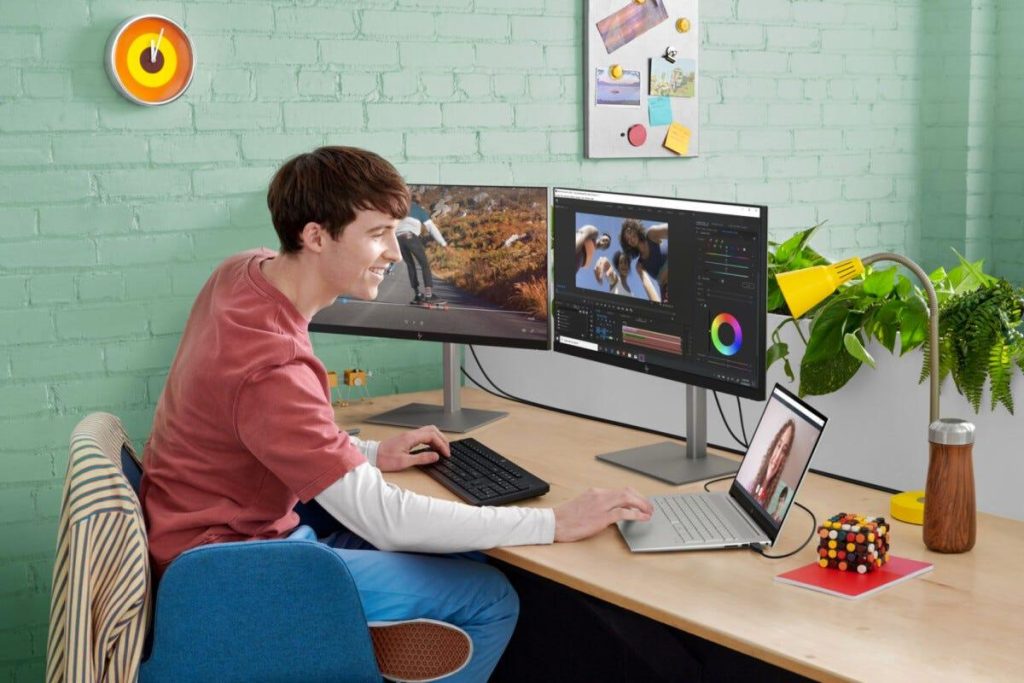In the market for a new computer monitor?
Because of all the options out there – namely, in size, shape, brand and price – strolling the aisles at your local big box electronics store could be an overwhelming experience.
The good news is displays are getting bigger, thinner and supporting higher resolution inputs and with advanced connectivity options for your laptop or desktop (Windows, Mac or Chrome OS). While there are premium solutions for more demanding users, prices of monitors are dropping for those with more modest needs (starting at about $130 for a brand-name 24-inch screen).
“There are a lot of exciting changes in the monitor category, which may create some confusion,” acknowledges Jeff Volpe, president of ViewSonic Americas, a visual display company based in Brea, California. “Therefore, you simply need to ask yourself a few questions before you buy, as it’s not a one-size-fits-all scenario.”
Those questions may include “what am I using it for?” and “where will I be using it?”
TALKING TECH NEWSLETTER: Sign up for our guide to the week’s biggest tech news
Whether you’re buying one for work, school or play, here are a few considerations for shoppers:
The basics
Whether it’s connected to a laptop or desktop, an external monitor is a smart, upgradeable purchase — but can be overwhelming to know which features to look for.
Regardless of the application, you’ll want to start with something high-resolution, suggests Volpe, “so it can handle the kinds of content you are consuming, creating or collaborating on.”
Whether it’s for looking at small text on a spreadsheet or editing videos as a content creator, most monitors today offer Full HD (1080p) resolution and many of them with support for 4K visuals, not unlike your television (and some up to 8K). Volpe says color accuracy is also key (especially for designers or photographers), along with features like high-dynamic range (HDR), which reproduces a wider range of brightness levels and higher contrast levels (resulting in whiter whites and darker blacks).
USEFUL IPHONE, ANDROID TRICKS: Get help measuring, magnifying and more
Ultrawide monitors have an aspect ratio of 21:9, which is not unlike having two monitors side by side – ideal for multitaskers who can get more done in less time.
Since prices are dropping, it’s ideal to look for a large display – perhaps north of 30 inches – which gives you more screen real estate for increased productivity, plus Volpe says you may also consider an ultrawide monitor, a dual-monitor setup or a curved model “to fit the environment you’re putting it in.”
(An ultrawide monitor generally has an aspect ratio of 21:9 opposed to a 16:9 widescreen display.)
If it’s for gaming, IPS monitors have come a long way over the past few years, providing good color accuracy and higher refresh rates (see below). OLED monitors are sweet, but pricey.
Portability
Those in the workforce may recognize there’s a booming “hybrid” model emerging, which fuses in-office and remote work.
As such, this post-pandemic “work from anywhere” movement has given rise to portable monitors, which lets you set up a dual-screen space to remain productive from virtually anywhere. Starting at about $240, these displays look like tablets and plug into a laptop’s USB-C port, to mirror or extend the desktop – plus this one single cable delivers video, audio and power.
Pair your laptop with a second display – that’s about the same size – for a dual-screen setup, whether you’re in a hotel room, at home, in the office, or a shared workspace environment. And they fit right in your laptop bag.
Available in touch and non-touch models, portable monitors are ideal for remote/hybrid workers, business travelers and digital nomads, says Volpe.
Ergonomics
Naturally, there are health concerns with sitting at a computer all day, from carpel tunnel syndrome and other mouse and keyboard-related repetitive stress injuries (RSIs) to eye, back or neck strain.
The problem may be exasperated with remote/hybrid employees since their homes weren’t necessarily designed for office work.
“Ergonomic” features in a monitor may include the ability to tilt, swivel, pivot and make height adjustments – which is commonplace these days, even for entry-level models – so you’re not turning your head (or craning your neck) to look at the screen. Some can be mounted to a desk or wall, via a flexible arm, which can also free up desk space.
Flicker-free technology and blue light filters can also help ease eye strain.
On a related note, the 20-20-20 rule is worth noting: Every 20 minutes, take a 20-second break and focus your eyes on something at least 20 feet away. (Also, try to get some exercise during the day. Even a walk around the block helps.)
Gaming
If you’re into computer games (or have your console connected to your monitor), speed is an important consideration when buying a new monitor.
“High refresh rates are important, as gamers need that throughput, to keep up with fast-paced games or videos,” says Volpe.
PC GAMING: A sweatproof mouse and more gear to help you level up
Look for a refresh rate of at least 120Hz (and a response time of no more than 3 milliseconds), plus a monitor with either G-Sync or FreeSync technology is also a good idea, to help deliver much smoother gameplay.
Aesthetically, some monitors also have RGB lighting to sync colors with gaming content.
Finally, look for a monitor with several port options, including USB-C and HDMI, plus some have extra features like the ability to charge your Qi-compatible smartphone wirelessly on its base.
Source: USA TODAY

